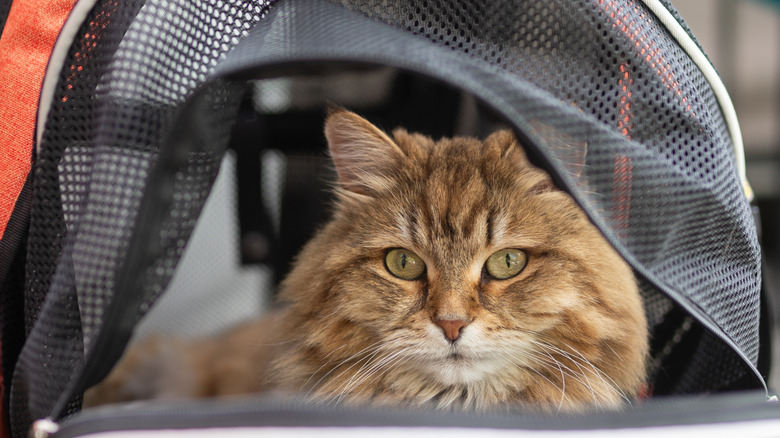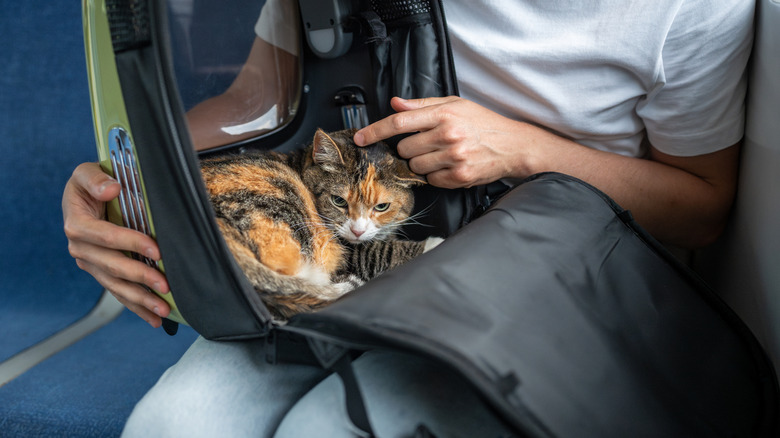Is Traveling With A Cat Backpack Cruel? Here's What A Professional Cat Trainer Says
You've probably seen it before: A tiny face peeks through the mesh of what looks like a space-pod backpack, strapped to someone's back as they stroll through a neighborhood, wait at an airport terminal, or even hike a trail. That's a cat in a backpack: a trend that's becoming increasingly popular among cat parents. But even if it looks cute and may admittedly be convenient, it's essential to ask: Is it safe to travel with a cat backpack, or is it cruel?
To better understand whether backpacks are truly safe for cats, Explore spoke with Joey Lusvardi, a certified cat behavior consultant and professional cat trainer at Class Act Cats, based in Minneapolis, Minnesota. His answer? It depends. "As with many things involving cats, it depends on the individual cat," Lusvardi said. Most cats are creatures of habit. They form strong attachments to their environment, rely on routine, and feel safest when they have control over their space. "I know a lot of people want to take their cats on adventures as a way to enhance their wellbeing or as a fun thing," Lusvardi said. "If you're the only one having fun, it's actually more harmful to your cat's wellbeing to take them out. It's okay if your cat isn't an adventure cat!" However, if your cat does enjoy being out and about, then keeping them safe should be your top priority.
How to decide whether or not to use a cat backpack
While cats might not speak English, they always find a way to communicate with us — especially when something feels wrong. Often, they express their pain or discomfort in subtle ways, and stress can show up as restlessness, panting, or sudden quietness. "Most of the cats I see in bubble backpacks are showing signs of stress. Some of the signs are subtle, but they don't appear to be having a good time," Lusvardi explained. "In those cases, it's not ethical to force your cat to do something they don't like just because you want them to do it." He also pointed out that many bubble backpacks are too small, don't have great ventilation, and tend to bounce when you walk, which can make your cat uncomfortable in many ways. He recommends using a different type of carrier instead of a bubble backpack for safer, more comfortable travel.
Harnessing can be a great option, but only when done thoughtfully — otherwise, avoid using it. As Lusvardi clarifies, harnessing requires patience and care, as rushing the process could be detrimental to your cat. "For harnesses specifically," he said, "forcing the harness on your cat is going to make them very uncomfortable, so unless you're willing to put in the work to gradually get them used to it, it's better to find another way to bond with your cat." It might be generally helpful for you, as a cat owner, to learn these essential tips for taking your cat camping, plus some guidelines for taking your cat on a road trip.
Beyond cat backpacks: How to travel safely with your cat
The idea of outdoor time for cats can be appealing, especially when the weather is nice and you want to include them in your daily routine — but without proper preparation, it can actually be cruel or unsafe for your cat. The problem goes deeper when people try to physically alter their cats — like through declawing — to make them easier to travel with. But you should never declaw your cat, as our expert Joey Lusvardi warns: "Don't get your cat declawed. This isn't a good idea in general, but if your cat gets out, they'll need their claws to defend themselves." Some cats even become anxious or aggressive after the surgery, which is harmful and painful for cats. Lusvardi's video on why declawing is harmful breaks it down further.
Moreover, no matter how secure your setup seems, microchipping is a must. "Make sure your cat is microchipped so if they do get out, you will be more likely to reunite with them," Lusvardi explained. Scottish SPCA told the story of a cat who was reunited with her family after being missing for two years because she had a microchip. Lusvardi also advises being mindful of potential dangers when bringing your cat outside. "Keep an eye out for things that could injure your cat or make them sick, such as toxic plants, sharp objects, or other animals," he shared. Lastly, if you're traveling by air especially, make sure to check if your cat's carrier is airline-approved, and be sure to get all necessary information about airline pet fees ahead of time.


